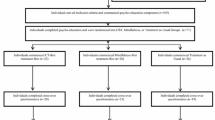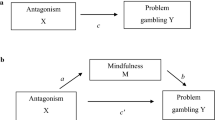Abstract
Previous studies have found an inverse relationship between mindfulness and problem gambling severity. This paper presents the findings from two studies of treatment seeking problem gamblers designed to explore the role of mindfulness in problem gambling. Treatment-seeking problem gamblers displayed significantly lower mindfulness scores than adult community members and university students. Mindfulness was significantly related to most indices of gambling, and psychological distress was an important mechanism in these relationships. Rumination, emotion dysregulation and thought suppression were also implicated as mediators in the inverse relationship between mindfulness and psychological distress. Taken together, the findings provide theoretical support for existing models of mindfulness which suggest that mindfulness operates by reducing psychological distress through these cognitive mechanisms. They also suggest that mindfulness training may be a new and innovative avenue for therapy to improve treatment effectiveness for problem gambling.
Similar content being viewed by others
References
Arch, J. J., & Craske, M. G. (2006). Mechanisms of mindfulness: Emotion regulation following a focussed breathing induction. Behav Res Ther, 44, 1849–1858.
Atlas, G. D., & Peterson, C. (1990). Explanatory style and gambling: How pessimists respond to losing wagers. Behav Res Ther, 28(6), 523–529.
Baer, R. A., Smith, G. T., Hopkins, J., Krietemeyer, J., & Toney, L. (2006). Using self-report methods to explore facets of mindfulness. Assessment, 13(1), 27–45.
Blaszczynski, A., & Nower, L. (2002). A pathways model for problem and pathological gambling. Addiction, 97(5), 487–499.
Borders, A., Earleywine, M., & Jajodia, A. (2010). Could mindfulness decrease anger, hostility, and aggression by decreasing rumination? Aggress Behav, 36, 28–44.
Bowen, S., Witkiewitz, K., Dillworth, T. M., & Marlatt, G. A. (2007). The role of thought suppression in the relationship between mindfulness meditation and alcohol use. Addict Behav, 32, 2324–2328.
Brown, K. W., & Ryan, R. M. (2003). The benefits of being present: Mindfulness and its role in psychological well-being. J Pers Soc Psychol, 84(4), 822–848.
Carlbring, P., & Smit, F. (2008). Randomized trial of internet-delivered self-help with telephone support for pathological gamblers. J Consult Clin Psychol, 76, 1090–1094.
Carmody, J., Baer, R. A., Lykins, E. L. B., & Olendzki, N. (2009). An empirical study of the mechanisms of mindfulness in a mindfulness-based stress reduction program. J Clin Psychol, 65, 613–626.
Chambers, R., Gullone, E., & Allen, N. B. (2009). Mindful emotion regulation: An integrative review. Clin Psychol Rev, 29, 560–572.
Christensen, D. R., Dowling, N. A., Jackson, A. C., Brown, M., Russo, J., Francis, K., & Umemoto, A. (2013). A pilot of an abridged Dialectical Behavior Therapy program as a treatment for problem gambling. Behaviour Change, 30, 117–137.
Ciarrocchi, J. W. (2002). Counseling problem gamblers: A self regulation manual for individual and family therapy. San Diego: Academic Press.
Coffey, K. A., & Hartman, M. (2008). Mechanisms of action in the inverse relationship between mindfulness and psychological distress. Complementary Health Practice Review, 13(2), 79–91.
Cowlishaw, S., Merkouris, S., Dowling, N., Anderson, C., Jackson, A., & Thomas, S. A. (2012). Psychological interventions for the treatment of pathological and problem gambling. Cochrane Database of Systematic Reviews, 11. Art. No.: CD008937.
de Lisle, S., Dowling, N., & Allen, J. (2011). Mindfulness-based cognitive therapy for problem gambling. Journal of Clinical Case Studies, 10, 210–228.
de Lisle, S., Dowling, N. A., & Allen, S. J. (2012). Mindfulness and problem gambling: A review of the literature. J Gambl Stud, 28, 719–739.
Dowling, N. (2009). Client characteristics associated with treatment attrition and outcome in female pathological gambling. Addiction Research and Theory, 17(2), 205–219.
Dowling, N., Smith, D., & Thomas, T. (2006). Treatment of female pathological gambling: Efficacy of a cognitive-behavioural approach. J Gambl Stud, 22, 355–372.
Dowling, N., Smith, D., & Thomas, T. (2007). A comparison of individual and group cognitive behavioral treatment for female pathological gambling. Behav Res Ther, 45, 2192–2202.
Dowling, N., Smith, D., & Thomas, T. (2009). A preliminary investigation of abstinence and controlled gambling as self-selected goals of treatment for female pathological gambling. J Gambl Stud, 25(2), 201–214.
Feldman, G., Hayes, A., Kumar, S., Greeson, J., & Laurenceau, J.-P. (2007). Mindfulness and emotion regulation: The development and initial validation of the cognitive and effective mindfulness scale-revised (CAMS-R). Journal of Psychopathology and Behavioral Assessment, 29(3), 177–190.
Ferris, J., & Wynne, H. (2001). The Canadian Problem Gambling Index: User Manual. Ottawa: Canadian Centre on Substance Abuse.
Hayes, S. C., & Feldman, G. (2004). Clarifying the construct of mindfulness in the context of emotion regulation and the process of change in therapy. Clinical Psychology: Science and Practice, 11(3), 255–262.
Jackson, A. C., Wynne, H., Dowling, N. A., Tomnay, J. E., & Thomas, S. A. (2010). Using the CPGI to determine problem gambling prevalence in Australia: Measurement issues. International Journal of Mental Health and Addiction, 8, 570–582.
Jain, S., Shapiro, S. L., Swanick, S., Roesch, S. C., Mills, P. J., Bell, I., et al. (2007). A randomized controlled trial of mindfulness meditation versus relaxation training: Effects on distress, positive states of mind, rumination, and distraction. Ann Behav Med, 33, 11–21.
Kessler, R. C., Andrews, G., Colpe, L. J., Hiripi, E., Mroczek, D. K., Normand, S. L., et al. (2002). Short screening scales to monitor population prevalences and trends in non-specific psychological distress. Psychol Med, 32(6), 959–976.
Korman, L., Collins, J., Littman-Sharp, N., Skinner, W., McMain, S., & Mercado, V. (2008). Randomized control trial of an integrated therapy for comorbid anger and gambling. Psychother Res, 18, 454–465.
Ladouceur, R., Lachance, S., & Fournier, P. M. (2009). Is control a viable goal in the treatment of pathological gambling? Behav Res Ther, 47(3), 189–197.
Lakey, C. E., Campbell, W. K., Brown, K. W., & Goodie, A. S. (2007). Dispositional mindfulness as a predictor of the severity of gambling outcomes. Personality and Individual Differences, 43, 1698–1710.
Lee, T. K., LaBrie, R. A., Grant, J. E., Kim, S. W., & Shaffer, H. J. (2008). The structure of pathological gambling among Korean gamblers: A cluster and factor analysis of clinical and demographic characteristics. International Journal of Mental Health and Addiction, 6, 551–563.
Linehan, M. M. (1993). Cognitive-Behavioural Treatment of Borderline Personality Disorder. New York: Guilford Press.
Lorains, F. K., Cowlishaw, S., Thomas, S. (2011). Prevalence of comorbid disorders in problem and pathological gambling: Systematic review and meta-analysis of population surveys. Manuscript submitted for publication.
McIntosh, W. D., & Martin, L. L. (1992). The cybernetics of happiness: The relation between goal attainment, rumination, and affect. In M. S. Clark (Ed.), Review of personality and social psychology (Vol. 14, pp. 222–246). Newbury Park: Sage Publications.
Najavits, L. M. (2003). How to design an effective treatment outcome study. J Gambl Stud, 19, 317–337.
Orford, J., Morison, V., & Somers, M. (1996). Drinking and gambling: A comparison with implications for theories of addiction. Drug Alcohol Rev, 15, 47–56.
Pallant, J. (2005). SPSS Survival Manual. Crows Nest: Allen & Unwin.
Petry, N. M. (2005). Pathological gambling: Etiology, comorbidity, and treatment. Washington, D.C: American Psychological Association.
Petry, N. M., Ammerman, Y., Bohl, J., Doersch, A., Gay, H., Kadden, R., et al. (2006). Cognitive-behavioral therapy for pathological gamblers. J Consult Clin Psychol, 74(3), 555–567.
Preacher, K. J., & Hayes, A. F. (2008). Asympotic and resampling ‘procedures for assessing and comparing indirect effects in ’multiple mediator models. Behav Res Methods, 40, 879–891.
Ramel, W., Goldin, P. R., Carmona, P. E., & McQuaid, J. R. (2004). The effects of mindfulness meditation on cognitive processes and affect in patients with past depression. Cognitive Therapy and Research, 28(4), 433–455.
Ratelle, C. F., Vallerand, R. J., Mageau, G. A., Rousseau, F. L., & Provencher, P. (2004). When passion leads to problematic outcomes: A look at gambling. J Gambl Stud, 20(2), 105–119.
Raylu, N., & Oei, T. P. S. (2004). The Gambling Urge Scale (GUS): Development, confirmatory factor validation and psychometric properties. Psychol Addict Behav, 18, 100–105.
Reynolds, B., & Karraker, K. (2003). A Big Five model of disposition and situation interaction: why a “helpful” person may not always behave helpfully. New Ideas in Psychology, 21, 1–13.
Riley, B. (2012). Experiential avoidance mediates the association between thought suppression and mindfulness with problem gambling. Journal of Gambling Studies. Online First.
Salovey, P., Mayer, J. D., Goldman, S., Turvey, C., & Palfai, T. (1995). Emotional attention, clarity, and repair: Exploring emotional intelligence using the trait meta-mood scale. In J. D. Pennebaker (Ed.), Emotional, Disclosure, and Health (pp. 125–154). Washington, DC: American Psychological Association.
Schmidt, R. E., Gay, P., Courvoisier, D., Oise Jermann, F., Ceschi, G., David, M., et al. (2009). Anatomy of the White Bear Suppression Inventory (WBSI): A review of previous findings and a new approach. Journal of Personality Assessment, 91(4), 323–330.
Segal, Z. V., Williams, J. M. G., & Teasdale, J. D. (2002). Mindfulness-Based Cognitive Therapy for Depression: A New Approach to Preventing Relapse. New York: Guilford Press.
Shapiro, S. L., Carlson, L. E., Astin, J. A., & Freedman, B. (2006). Mechanisms of mindfulness. J Clin Psychol, 62(3), 373–386.
Shapiro, S., Brown, K., & Biegel, G. (2007). Teaching self-care to caregivers: Effects of Mindfulness-Based Stress Reduction on the mental health of therapists in training. Training and Education in Professional Psychology, 1(2), 105–115.
Shonin, E., van Gordon, W., & Griffiths, M. D. (2013a). Buddhist philosophy for the treatment of problem gambling. Journal of Behavioural Addictions, 2, 63–71.
Shonin, E., van Gordon, W., & Griffiths, M. D. (2013b). Mindfulness-based interventions for the treatment of problem gambling. Journal of the National Council on Problem Gambling, 16, 17–18.
Shonin, E., van Gordon, W. V., & Griffiths, M. D. (2013c). Cognitive behavioural therapy (CBT) and meditation awareness training (MAT) for the treatment of co-occurring schizophrenia and pathological gambling: A case study. International Journal of Mental Health and the Addictions. Available online.
Simons, J., & Gaher, R. (2005). The distress tolerance scale: Development and validation of a self-report measure. Motivation and Emotion, 29, 83–102.
Stewart, S. H., & Zack, M. (2008). Development and psychometric evaluation of a three-dimensional Gambling Motives Questionnaire. Addiction, 103, 1110–1117.
Tabachnick, B., & Fidell, L. S. (2001). Using Multivariate Statistics (4th ed.). Needham Heights, MA: Allyn & Bacon.
Teasdale, J. D., Segal, Z. V., & Williams, J. M. G. (1995). How does cognitive therapy prevent depressive relapse and why should attentional control (mindfulness) training help? Behavioral Research and Therapy, 33, 25–39.
Thomas, S. A., Merkouris, S. S., Radermacher, H. L., Dowling, N. A., Misso, M. L., Anderson, C. J., & Jackson, A. C. (2011). An Australian guideline for treatment in problem gambling: An abridged outline. Medical Journal of Australia, 195(11), 664–665.
Toneatto, T., Vettese, L., & Nguyen, L. (2007). The role of mindfulness in the cognitive-behavioural treatment of problem gambling. Journal of Gambling Issues, 19, 91–100.
Trapnell, P. D., & Campbell, J. D. (1999). Private self-consciousness and the five-factor model of personality: Distinguishing rumination from reflection. J Pers Soc Psychol, 76(2), 284–304.
Wegner, D. M. (1989). White bears and other unwanted thoughts: Suppression, obsession, and the psychology of mental control. London: The Guilford Press.
Wegner, D. M., & Erber, R. (1992). The hyperaccessibility of suppressed thoughts. J Pers Soc Psychol, 63, 903–912.
Wegner, D. M., & Zanakos, S. (1994). Chronic thought suppression. J Pers, 62, 615–640.
Author information
Authors and Affiliations
Corresponding author
Rights and permissions
About this article
Cite this article
de Lisle, S., Dowling, N.A. & Allen, J.S. Mechanisms of Action in the Relationship between Mindfulness and Problem Gambling Behaviour. Int J Ment Health Addiction 12, 206–225 (2014). https://doi.org/10.1007/s11469-014-9475-4
Published:
Issue Date:
DOI: https://doi.org/10.1007/s11469-014-9475-4




